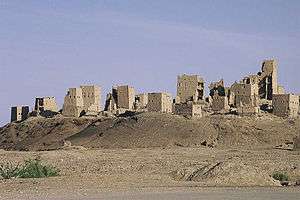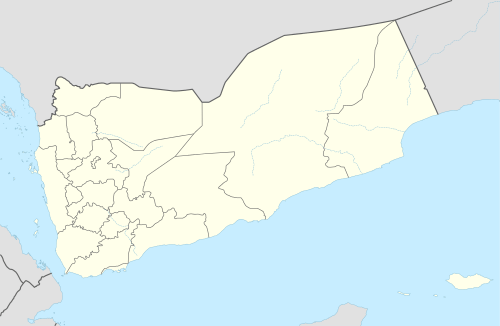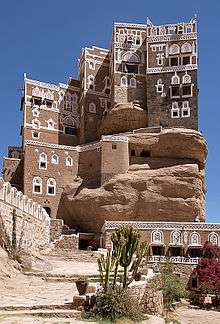Baraqish
| Baraqish | |
|---|---|
 | |
 Baraqish Location in Yemen | |
| Coordinates: 16°0′N 44°48′E / 16.000°N 44.800°E | |
| Country |
|
| Governorate | Al Jawf Governorate |
| Time zone | UTC+3 (Yemen Standard Time) |
Barāqish or Barāḳish or Aythel[1] (Arabic: براقش) is a town in north-western Yemen, 120 miles to the east of Sana'a in the province of al-Jawf on a high hill. It is located in Wādī Farda(h)Coordinates: 16°0′N 44°48′E / 16.000°N 44.800°E. It was known to the Greeks and Romans as Athlula (or Athrula), from the ancient Sabaean Yṯl (probably vocalized Yathill).[2]
Barāqish was inhabited from time immemorial; one generation building their houses on the ruins of the earlier ones. In the main area of the site, there still remain, the ruins of a dome, a mosque, a well and tower, as well as many pottery shards and pieces of glass. People lived in the town up to the 1960s but it has since been abandoned, and is at present being occupied by the military.
History and Archaeology
The ancient city of Yathill was surrounded by a wall 14 meters high, much of which is still visible today; this wall had 57 towers and two gates. Inscriptions mention that the wall was rebuilt by the Sabaeans in 450 BCE. Its origins are very archaic 1000 BCE, but it reached its peak of importance in about 400 BCE when it became the capital of the Minaean Kingdom. The Minaeans however shifted their capital to Qarnāwu, and Yathill remained a sort of religious center.
The ruins of a temple, located in the southern part of the city are considered by archaeologist to have been dedicated to the god Athtar. The temple is very typical of the Minaean style and consists of 16 columns and beams. There is another temple in the center of the city but only four of its columns are still erect.
A team of Italian archaeologists recently discovered a temple with its roof intact. Inside they found a number of stone tables or altars with bulls' heads at each end; it is however believed to have been a sanctuary to a god of healing.
A Roman army passed through it during the 20s B.C., under the command of Aelius Gallus.[3] The tomb of a Roman cavalryman, P. Cornelius, has been found there.[4]
References
- ↑ Sometimes also transliterated Baragish in accordance with the local Yemeni pronunciation. (e.g. Encyclopædia Britannica, 1911 ed.; but modern webpages also.)
- ↑ Cass. Dio 53.29.8; Strabo 820.
- ↑ Strabo: Geographica (xvi . 4 . 22).
- ↑ Rich, J.W. (1990): Cassius Dio: the Augustan Settlement (Roman History 53-55.9), p165
